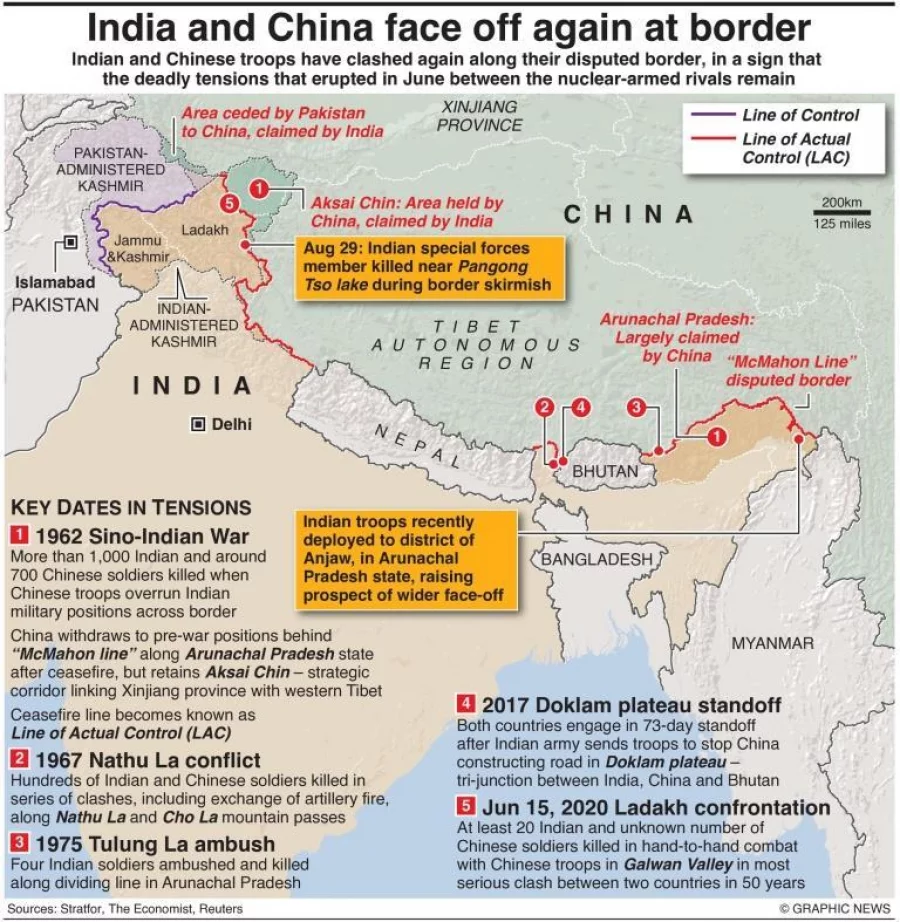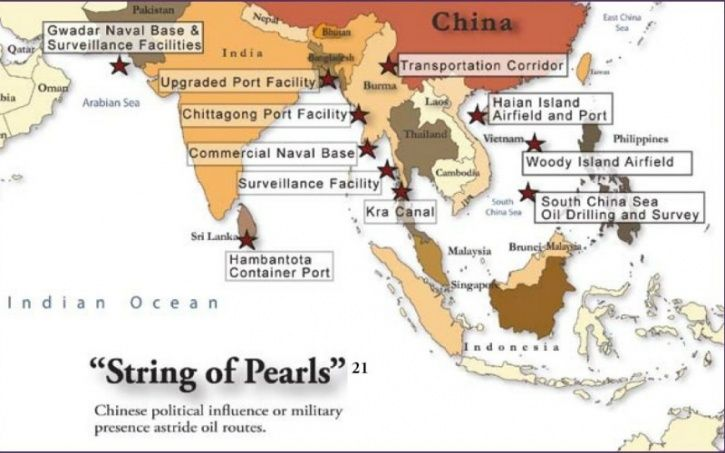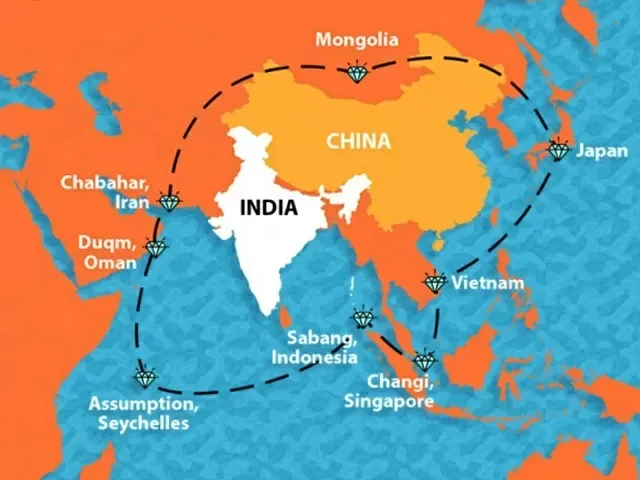International Relations
Rethinking India's Approach to China: Strategic Considerations
- 23 Nov 2023
- 21 min read
This editorial is based on “ India should not talk to China — even if Biden talks to Xi” which was published in The Indian Express on 22/11/2023. It talks about the recent development in QUAD partner's engagement with China and calls for a reassessment of its approach to engaging with China.
For Prelims: QUAD, Aksai Chin, McDonald Line, Line of Actual Control (LAC), China-Pakistan Economic Corridor (CPEC), Belt and Road Initiative (BRI), Salami Slicing Strategy, Debt Trap Diplomacy, Five Fingers of Tibet, Tibetan Autonomous Region (TAR), String of Pearls, I2U2, India-Middle East-Europe Economic Corridor (IMEC), International North-South Transport Corridor (INSTC), G7, Indian Ocean Rim Association, Necklace of Diamonds, Himalayan QUAD.
For Mains: Key Disputes between India-China Relations, Geopolitics behind China’s assertion, India’s response to Chinese aggression, Shifting International Politics is Affecting India-China Relations, Way Forward.
In recent weeks, India's QUAD partners—Australia, Japan, and the US—have rekindled
high-level political interactions with China. However, India is unwilling to resume political and economic discussions with China until the Ladakh military standoff, which started in spring 2020, is satisfactorily resolved.
This has reignited discussions on whether India should reassess its existing approach to engaging China in order to address a range of complex disputes.
What are the Key Disputes between India- China Relations?
- Border Disputes:
- Western Sector (Ladakh):
- The Johnson Line proposed by the British placed Aksai Chin in the princely state of Jammu and Kashmir.
- China rejected the Johnson Line and favored the McDonald Line, asserting control over Aksai Chin.
- Though Aksai Chin is administered by China, India’s official position on the issue is that, by virtue of it being a part of Jammu and Kashmir (Ladakh), the region remains an integral part of India.
- Middle Sector (Himachal Pradesh and Uttarakhand):
- The Middle Sector has a relatively minor dispute, with India and China exchanging maps where they broadly agree on the LAC.
- Eastern Sector (Arunachal Pradesh and Sikkim):
- China considers the McMahon Line illegal and unacceptable claiming that Tibetan representatives who had signed the 1914 Convention held in Shimla which delineated the McMahon Line on the map did not have the right to do so.
- Western Sector (Ladakh):
- Border Incursions:
- The border between India and China is not clearly demarcated throughout and there is no mutually agreed Line of Actual Control (LAC) along certain stretches.
- Border confrontations have occurred in different instances, including Demchok in 2014, Depsang in 2015, Doklam in 2017, and the Galwan incident in 2020.
- Water Sharing:
- China's advantageous geographical positioning creates an asymmetry that allows it to capitalize on the reliance of downstream nations, such as India, on hydrological data.
- There are concerns over China's dam-building activities on transboundary rivers, including the Brahmaputra, which have led to tensions over water-sharing issues.
- Tibet Issue:
- India hosts the Tibetan government-in-exile and spiritual leader the Dalai Lama, which has been a point of contention with China.
- China accuses India of supporting Tibetan separatism, while India maintains that it respects the "One China" policy but allows the Tibetan community to reside in India.
- Trade Imbalance:
- India’s trade deficit with China reached the historically high level of USD 87 billion in 2022.
- Complex regulatory requirements, intellectual property rights violations, and a lack of transparency in business dealings present challenges for Indian businesses seeking access to the Chinese market.
- Concerns over Belt and Road Initiative (BRI):
- India's main objection to the BRI is that it includes the China-Pakistan Economic Corridor (CPEC), which passes through the Pakistan-occupied Kashmir (PoK), a territory that India claims as its own.
- India also argues that the BRI projects should respect the international norms, rule of law, and financial sustainability, and should not create debt traps or environmental and social risks for the host countries.
What are the Geopolitics Behind China’s Assertion?
- China’s Salami Slicing Strategy:
- In military terms, Salami Slicing refers to a divide-and-conquer strategy involving incremental threats and alliances to overcome opposition and acquire new territories.
- In the case of China, Salami Slicing is evident in its approach to territorial expansion in both the South China Sea and the Himalayan regions, with the Doklam standoff often seen as a manifestation of China's salami-slicing tactics in the Himalayas.
- Chinese Debt Trap Diplomacy:
- China's debt trap diplomacy refers to a strategy in which China extends loans to developing countries, often for infrastructure projects, with the intention of creating economic dependence
- As a result, China may gain strategic leverage or control over key assets if the debtor is unable to fulfill its financial obligations. Critics argue that this approach allows China to expand its influence globally by exploiting the economic vulnerabilities of borrowing nations.
- China’s Five Fingers of Tibet Strategy:
- The "Five Fingers of Tibet" is a term used to describe China's territorial claims and strategic approach in relation to Tibet.
- The metaphorical term describes Tibet as the palm, with China aspiring to control or influence the five surrounding regions, referred to as fingers.
- The metaphorical "fingers" represent the following areas:
- Ladakh: Gaining control over Ladakh would provide China with unimpeded access to Pakistan.
- Nepal: Exerting influence over Nepal would grant China strategic access to the heartland of India.
- Sikkim: Asserting control over Sikkim would offer China a tactical advantage in severing India's "Chicken Neck" (Siliguri Corridor), effectively isolating the northeastern states from the Indian mainland.
- Bhutan: Gaining control over Bhutan would bring China in proximity to Bangladesh, providing a potential route to the Bay of Bengal and enhancing China's regional influence.
- Arunachal Pradesh: Securing control over Arunachal Pradesh would enable China to dominate the entire northeastern region of India, extending its military reach and strategic influence in the area.
- Strategic Encirclement of India by China’s “String of Pearls”:
- China's "String of Pearls" refers to a geopolitical and strategic initiative that involves building a network of Chinese-funded, owned, or controlled ports and other maritime infrastructure facilities in strategic locations across the Indian Ocean.
- Some of the notable locations associated with China's String of Pearls include Gwadar Port in Pakistan, Hambantota Port in Sri Lanka, Chittagong Port in Bangladesh, and Djibouti in the Horn of Africa.
How is India Responding to China's Aggressive Measures?
- Global Strategic Alliances:
- India actively engages with like-minded nations to collectively address China's influence in the Indian Ocean Region
- QUAD: It is the grouping of four democracies –India, Australia, the US, and Japan. All four nations find a common ground of being democratic nations and also support the common interest of unhindered maritime trade and security.
- I2U2: It is a new grouping of India, Israel, the USA, and the UAE. Forming alliances with these countries strengthens India's geopolitical standing in the region.
- India-Middle East-Europe Economic Corridor (IMEC):
- Launched as an alternative trade and connectivity corridor, IMEC aims to strengthen India's presence in the Arabian Sea and the Middle East.
- Funded by the Partnership for Global Infrastructure Investment (PGII), it serves as a counter-initiative to China's Belt and Road Initiative (BRI) with the support of G7 nations.
- International North-South Transport Corridor (INSTC):
- INSTC, established through an agreement between India, Iran, and Russia, creates a comprehensive 7,200-km multi-mode transportation network connecting the Indian Ocean, Persian Gulf, and Caspian Sea.
- The key node, Chahbahar Port in Iran, strategically monitors China's activities in the Arabian Sea and the Strait of Hormuz, providing an alternative to the China-Pakistan Economic Corridor's (CPEC) Gwadar port.
- Indian Ocean Rim Association (IORA) :
- It is an intergovernmental organization established to promote economic cooperation and regional integration among countries bordering the Indian Ocean.
- IORA member states work on various initiatives related to trade, investment, and sustainable development in the Indian Ocean region (IOR).
- India’s Necklace of Diamonds Strategy:
- In response to China's String of Pearls strategy, India adopted the Necklace of Diamonds strategy, emphasizing the encirclement of China by enhancing its naval presence, expanding military bases, and strengthening diplomatic ties with regional nations.
- This strategy aims to counter China's military network and influence in the Indo-Pacific and Indian Ocean regions.
- In response to China's String of Pearls strategy, India adopted the Necklace of Diamonds strategy, emphasizing the encirclement of China by enhancing its naval presence, expanding military bases, and strengthening diplomatic ties with regional nations.
How Shifting International Politics is Affecting India-China Relations?
- USA:
- India has signed four foundational agreements as General Security of Military Information Agreement (GSOMIA), Logistics Support Agreement (LSA), Communications Interoperability and Security Memorandum of Agreement (CISMOA), and Basic Exchange and Cooperation Agreement for Geo-spatial Cooperation (BECA) with USA that cover areas of military information, logistics exchange, compatibility.
- By virtue of these agreements, India and the USA may collaborate and jointly counter Chinese strategies.
- Japan:
- India, in collaboration with Japan and Australia, has initiated the Supply Chain Resilience Initiative to reduce reliance on China.
- QUAD:
- In the global power dynamics, India is actively engaging through QUAD to counter Chinese unilateralism, while China collaborates with Russia, Pakistan, Iran, and Turkey to challenge the US-led liberal world order.
- Recently India’s Quad Partners Australia, Japan, and the US engaged in renewed high-level political discussions with China.
- Himalayan QUAD:
- This project involves China, Nepal, Pakistan, and Afghanistan as a counterweight to the QUAD.
- Pakistan:
- Pakistan signed a memorandum in 2013, a landmark agreement for long-term planning and development of CPEC, the BRI’s flagship project.
- To China, Pakistan serves not only as a client state but also as a significant tool to restrain India.
- Sri Lanka:
- Sri Lanka has also received massive funding under the BRI. Sri Lanka provides China with various naval capabilities to function in the Indian Ocean.
- China has acquired the strategic Hambantota Port from Sri Lanka bolstering Beijing’s String of Pearls
- The Colombo port city being built by China is being termed a ‘Chinese Colony’ by strategic experts in India and Sri Lanka.
- Bangladesh:
- Bangladesh joined the BRI in 2016, and bilateral relations with China have been growing since, much to India’s dismay.
- Bangladesh is being aided by China, but India–Bangladesh's cultural and geographical proximity will dominate. India and Bangladesh have mutual issues and interests that can be used by India to strengthen relations at any point.
- Nepal:
- Nepal joined the BRI agreement with China in 2017.
- China aims to build political links, but India's influence remains strong due to its dominant cultural influence.
- Maldives:
- Under President Yameen's leadership, there was a notable pivot toward China marked by substantial Chinese investments. Despite the election of Mohammad Muizzu as president, a trend of increasingly anti-India positions is becoming evident.
- The India-Maldives relationship suffered a setback when Maldives entered into a Free-Trade Agreement (FTA) with China in 2017.
- India has provided renewed economic assistance, undertaken infrastructure projects, and expanded defense cooperation to strengthen its influence in the region.
- Bhutan:
- Bhutan declines BRI partnership, fostering strong political and economic relations with India.
- India aids Bhutan in hydropower projects and proposes regional initiatives.
- Afghanistan:
- Following the Taliban takeover in Afghanistan, the Taliban has referred to China as the "most crucial partner" in the nation's reconstruction endeavors.
What Should be the Way Forward?
- To secure Peace, Prepare for War:
- India needs to prepare for the possibility of conflict with China which involves bolstering India's military capabilities.
- The Parliamentary Standing Committee on Defence has recommended that allocation for defense should be 3% of GDP to maintain India's deterrent posture.
- Development of infrastructure along the border, such as roads and bridges, can help both countries access remote areas and reduce the possibility of any misunderstandings or conflicts.
- Diplomatic Dialogue from a position of Strength:
- Compartmentalization of Issues: By isolating individual challenges, negotiators can develop solutions tailored to each particular aspect
- Address Border Disputes: Prioritize resolving ongoing border disputes through diplomatic means and negotiations.
- Engage in High-Level Talks: Both countries should engage in high-level diplomatic talks to discuss and resolve existing issues.
- The Foreign Ministers of India and China signed a ‘Five Points’ agreement to reduce the tension on the Ladakh border at Moscow in 2020.
- Implement Confidence-Building Measures (CBMs): Improve communication channels between the military forces of both countries to prevent misunderstandings and accidental escalations.
- Strategic Autonomy in Foreign Affairs:
- The geopolitical considerations of India’s China policy have an independent logic
- India should not be the only QUAD nation or a significant power not engaged in a dialogue with China.
- Rather than expressing apprehension about potential shifts in US-China relations, India should prioritize leveraging current opportunities with the US and the West.
- The strategic focus should seek to hasten India's rise in the global power hierarchy, diminish the strategic gap with China, and strengthen military deterrence.
- Economic Cooperation:
- Diversify Imports: India needs to reduce its dependence on Chinese imports by diversifying its imports from other countries such as Vietnam, South Korea, Japan, Taiwan, and Indonesia.
- Boost Exports: India can focus on increasing its exports to China. India should focus on exporting high-value products like engineering goods, electronics, pharmaceuticals, and chemicals.
- Develop Domestic Industries: India needs to develop its domestic industries to reduce its reliance on imports. This will not only help reduce the trade imbalance but also create employment opportunities in India.
- Review FTAs: India should also consider signing an FTA with China to increase exports and reduce the trade deficit.
- Encourage Cultural Exchanges:
- Encourage People-to-People Contacts: Promote cultural exchanges, educational programs, and tourism to enhance understanding between the people of India and China.
- Promote Track II Dialogues: Encourage non-governmental exchanges, involving scholars, think tanks, and civil society, to contribute fresh perspectives and ideas.
- Collaborate in International Cooperation:
- Collaborate on Global Issues: Work together on global challenges such as climate change, public health, and counter-terrorism, showcasing joint leadership on the world stage.
- Joining Multilateral Platforms: Engage in multilateral platforms to address shared concerns and foster cooperation on regional and global issues.
- High Tech is the new Foreign Policy:
- Joint Research and Innovation: Encourage collaboration in technology, research, and innovation to benefit both nations economically and technologically.
- Joint Efforts on Environmental Issues: Collaborate on environmental initiatives, such as addressing air pollution and water management, to highlight shared interests.
- Emerge as a Net Security provider in the Indo-Pacific Region:
- Maritime Security: India should participate in efforts to ensure the safety and freedom of navigation in critical sea lanes, contributing to the overall security architecture in the Indo-Pacific.
- Humanitarian Assistance: India should keep its commitment to regional security by actively participating in humanitarian assistance and disaster relief operations.
Conclusion:
Assessing changes in great power dynamics and formulating responses constitute a fundamental aspect of any nation's foreign policy. For India, the key focus should be on capitalizing on emerging opportunities to enhance its alliances with the US and adeptly navigate complex relations with China. India's ascension in the international system positions it well to effectively manage any abrupt shifts in great power relations.
|
Drishti Mains Question: What are the key points of contention between India and China, and what strategies is China employing to establish influence in the Indo-Pacific region? In the face of changing power dynamics, what diplomatic approaches would you suggest for India’s foreign policy? |
UPSC Civil Services Examination Previous Year Question (PYQ)
Prelims
Q. “Belt and Road Initiative” is sometimes mentioned in the news in the context of the affairs of : (2016)
(a) African Union
(b) Brazil
(c) European Union
(d) China
Ans: D
Mains
Q. The China-Pakistan Economic Corridor (CPEC) is viewed as a cardinal subset of China’s larger ‘One Belt One Road’ initiative. Give a brief description of CPEC and enumerate the reasons why India has distanced itself from the same. (2018)










